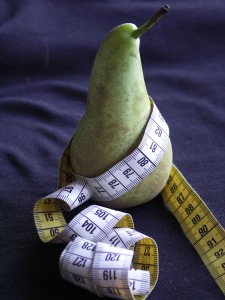How many calories do I need to lose weight? Calculating the amount of calories you must eat each day to lose weight is a quite simple, three step process. The most commonly used method to calculate how many calories a day to loose weight is the Harris Benedict equation. Here is the Harris Benedict equation:
BMR = 655.0 + (4.350 x weight in pounds)+ (4.70 x height in inches)- (4.70 x age)
 All you have to do is input your weight, height and age. The resultant number you obtain is the total amount of calories you should eat each day to survive (also referred to as BMR, the basal metabolic rate). For instance, a 50 year old woman whose height is 5’7” while weighing 160 lbs. would have the basal metabolic rate of around 1441 calories.
All you have to do is input your weight, height and age. The resultant number you obtain is the total amount of calories you should eat each day to survive (also referred to as BMR, the basal metabolic rate). For instance, a 50 year old woman whose height is 5’7” while weighing 160 lbs. would have the basal metabolic rate of around 1441 calories.
Contents
Calculate the calories needed for your activity trough the day
Since you can’t lie in bed all day long, you will burn more number of calories than this. In order to estimate the number of calories you can burn in your daily activities, we will utilize the factors mentioned below:
- Sedentary: Minimal movement, reading, much time watching TV among others. Activity factor = 1.40
- Light activity: Such as office work, around one hour of moderate activity/ exercise during the day. The activity factor = 1.50
- Moderate activity: Light manual/ physical work during the day and more active lifestyle. The activity factor = 1.60
- Very active: Full time athlete, active military, hard manual/ physical labor job. The activity factor = 1.90
Then, multiply your respective activity factor by the BMR. For this example used, we will settle on an activity factor of 1.50 (common for majority of people) and then multiply that by the number of calories (1441) to give 2161 calories. This amount is the total number of calories that you should eat each day in order to maintain your weight and is also known as total-calorie needs. However, to lose some weight, you have to consume less than this.
But, how many calories? That’s our next step
Determining the number of calories to burn each day is where the weight loss turns to an art than science since there are numerous variables that can affect the calories in <calories out equation such as:
- The types of exercises you are doing: interval and resistance training would cut more calories after you finish exercising as opposed to the traditional aerobic training.
- The type of food you are eating: high protein diets tend to burn more calories because protein takes a greater effort for the body to digest and then metabolize.
- How much weight you need to lose: if you want to lose around 25 or more pounds to attain your weight goal, then your total-calorie requirements, as calculated above, is too high. This arises from the fact that the calorie needs of fat were treated as being equal to the lean tissues (bones, muscles and organs). But in reality, the body fat has got a lower caloric need (almost close to zero).
- Your individual metabolism: Harris Benedict equation or any other equation that approximates your total-calorie needs, remains just that- an estimate. The equations are usually based on average, and you may not be average.
Traditionally, people are advised to subtract around 500 to 1000 calories from their total-calorie needs to lose about 1-2 ponds every week. This is based on the fact that a 500 calorie daily deficit produces a 3500 calorie weekly deficit; which is the amount of calories you should burn in order to lose 1 pound of fat.
For those who are weight training, having interval cardio sessions within the week, and consuming a moderate protein / carb controlled diet, it’s recommendable to only subtract around 250 calories from your total-calorie needs (or about 500 calories if you want to lose more than twenty five pounds to attain your weight goal). You will get remarkable results while being free to eat more. Referring to the example above, the woman would have to consume 1900 calories every day to lose weight.
Put all these to test and it would answer your question:
how many calories do i need to lose weight. After two weeks, check how much weight you’ve lost. If you are not losing at your preferable rate, opt to carry out more activates before you burn more calories. If you want to cut-out more calories, burn another 250 and then test the new calorie level for two weeks.
Leave a Reply